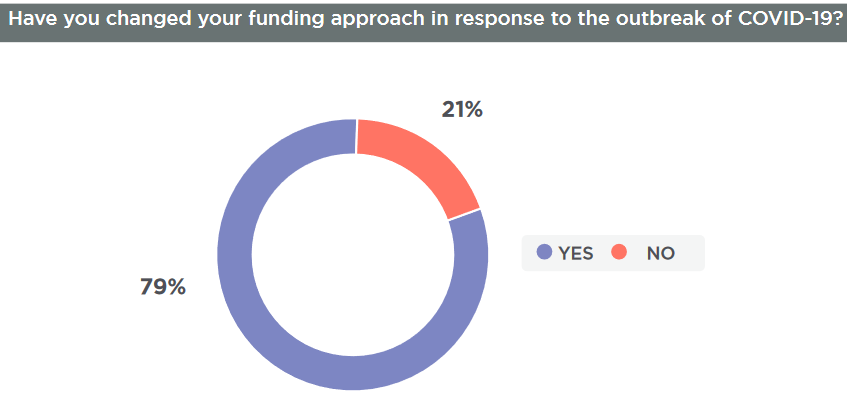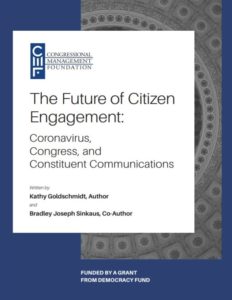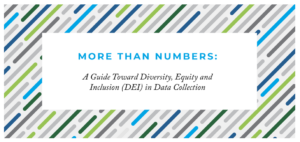September
2020
September 2, 2020
From the Field
Accessibility, Inclusivity in Data Collection
More than Numbers: A Guide Toward Diversity, Equity, and Inclusion (DEI) in Data Collection, published by the Charles and Lynn Schusterman Family Foundation, provides best practices for collecting data about individuals in an inclusive and respectful way. It includes frameworks for deciding what data to collect and offers example questions for a variety of different demographic topics to use when developing surveys, questionnaires and forms. It also contains a list of further resources for creating accessible surveys and collecting sensitive information.
Funders’ Shifting Practices
 COVID-19: How Have Funders Changed Their Approach & What Will Stick?, a joint publication from Exponent Philanthropy and PEAK Grantmaking, analyzes a survey of 1,000 grant makers to measure how the pandemic has changed their funding practices. The majority of funders have changed their approach to grant making, with small funders changing the most and giving more than usual. Funders are collaborating with other nonprofits to create relief funds and are shifting focus to pay increased attention to individuals. Internally, grant makers are responding to their grantees with flexibility and moving to virtual operations.
COVID-19: How Have Funders Changed Their Approach & What Will Stick?, a joint publication from Exponent Philanthropy and PEAK Grantmaking, analyzes a survey of 1,000 grant makers to measure how the pandemic has changed their funding practices. The majority of funders have changed their approach to grant making, with small funders changing the most and giving more than usual. Funders are collaborating with other nonprofits to create relief funds and are shifting focus to pay increased attention to individuals. Internally, grant makers are responding to their grantees with flexibility and moving to virtual operations.
Performing Arts Revenue and COVID-19
The Results Group for the Arts (TRG Arts) has published a report detailing the impact of the COVID-19 pandemic on revenue streams of performing arts organizations. COVID-19 Sector Benchmark: Insight Report June 2020 looks at whether new philanthropic donations have been able to replace lost ticket income by comparing donations to performing arts organizations in North America and the United Kingdom in 2020 to donations made in 2019. Overall, donations in North America have not replaced ticket sale losses and have fallen 2% in 2020 compared to 2019.
Creative Employment Demand and Pay
Nesta’s new report, For Love or Money? Graduate Motivations and the Economic Returns of Creative Higher Education Inside and Outside the Creative Industries, examines the relationship between a creative undergraduate degree and postgraduation employment. This study finds that while employment and job fit is high for creative degrees, pay remains lower than for noncreative degrees. Importantly, Nesta suggests that this economic disequilibrium—high employment, low pay—stems from differences in motivation among graduates and makes compensation an ineffective indicator of market value. Although focused on Britain’s creative economy, the research offers compelling evidence that, while creative skills are in high demand, pay is not an effective measurement of that demand.
How Congress Engages with Constituents during COVID-19
 The Future of Citizen Engagement: Coronavirus, Congress, and Constituent Communications, from the Congressional Management Foundation, studied how members of Congress are exploring virtual tools to interact with their constituents as a result of COVID-19. Based on a survey of more than 120 congressional staffers in the U.S. House and Senate, the report addresses how congressional offices adapted their communications strategies at the beginning of the pandemic, the techniques members used to diversify their constituent outreach and current methods of engagement they are employing. Learn how to stay in contact with your elected officials during COVID-19 with The Practical Advocate: Virtual Advocacy.
The Future of Citizen Engagement: Coronavirus, Congress, and Constituent Communications, from the Congressional Management Foundation, studied how members of Congress are exploring virtual tools to interact with their constituents as a result of COVID-19. Based on a survey of more than 120 congressional staffers in the U.S. House and Senate, the report addresses how congressional offices adapted their communications strategies at the beginning of the pandemic, the techniques members used to diversify their constituent outreach and current methods of engagement they are employing. Learn how to stay in contact with your elected officials during COVID-19 with The Practical Advocate: Virtual Advocacy.
In this Issue
From the President and CEO
State to State
- New Jersey, Missouri, Nebraska: COVID-19 Guidance for Resuming Arts Activities
- DE, MD, NJ, NY, PA, VA, WV: 2020 Mid-Atlantic Teaching Artists Virtual Retreat
Legislative Update
The Research Digest
Announcements and Resources
More Notes from NASAA
SubscribeSubscribe
×
To receive information regarding updates to our newslettter. Please fill out the form below.

